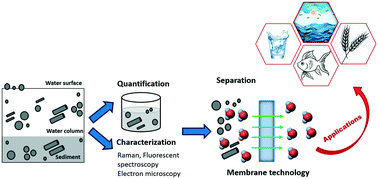Microplastics in marine environment: a review on sources, classification, and potential remediation by membrane technology
Abstract
The presence of microplastics in marine environment has been a pollution problem for years; however, people have only recently become aware of it, similar to the situation in the last few decades with global warming due to greenhouse gases. Microplastics are pollutants that are highly stable to complete biodegradation, and there is a high risk that they can enter the food chain (e.g. fish or agriculture products) because of the fact that secondary plastics (in principle, as small as monomers and oligomers) generated from the evolution of primary plastics (that directly spread in the environment) require more specific separation processes for their removal. In this review, firstly, we focus on the classification of microplastics and potential remediation technologies to be applied depending on their size. Secondly, membrane technologies (microfiltration, ultrafiltration and nanofiltration) are presented in the context of microplastics removal, revealing their suitability for the task and a future path of research and development to be carried out to mitigate the problem.

- This article is part of the themed collections: World Earth Day and Best Papers 2021 - Environmental Science: Water Research & Technology


 Please wait while we load your content...
Please wait while we load your content...